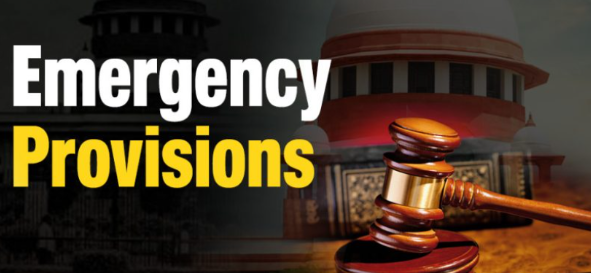Impact of Emergency Provisions on Centre-State Relations (GS Paper 2, Governance)

Context
- The recent violence in Manipur has sparked renewed debate regarding Centre-State relations, particularly concerning the application of emergency provisions outlined in the Indian Constitution.
- This discourse is crucial as it touches upon the balance of power between the Union and the States, which is fundamental to India’s federal structure.
Federal Structure of India
India's federal system is characterized by the division of powers between the Central government and State governments. The Seventh Schedule of the Constitution categorizes powers into three lists:
- Union List: Subjects on which only the Centre can legislate (e.g., defense, foreign affairs).
- State List: Subjects exclusively within the jurisdiction of States (e.g., police, public health).
- Concurrent List: Subjects where both the Centre and States can legislate (e.g., education, marriage).
While States are responsible for maintaining law and order, the Centre has the authority to intervene under specific conditions outlined in the Constitution, particularly in times of emergency.
Emergency Provisions in the Constitution
The emergency provisions in the Constitution are primarily encapsulated in Part XVIII, specifically Articles 355 and 356:
- Article 355: This article mandates the Centre to protect every State against external aggression and internal disturbances. It emphasizes the duty of the Union to ensure that State governments function in accordance with constitutional provisions, thereby establishing a framework for intervention when necessary.
- Article 356: This article allows the President to assume control of a State government if it is unable to function according to the Constitution. This can lead to the imposition of President’s rule, effectively sidelining the elected government of that State.
Comparison with Other Countries
- The federal framework in India is distinct from that in countries like the United States and Australia.
- While both these countries also incorporate mechanisms for protecting States, they do not allow for the direct removal of State governments.
- In India, the Centre possesses significant powers that can disrupt the autonomy of State governments, raising questions about federalism and democratic governance.
B.R. Ambedkar’s Perspective
- Dr. B.R. Ambedkar, the chief architect of the Indian Constitution, believed that Article 355 was a necessary safeguard to prevent arbitrary intervention by the Centre.
- He argued that the Centre’s intervention should be constitutionally justified, and not an excuse for overreach.
- The intent was to ensure that any action taken under Article 356 had a legitimate basis, thereby preserving the integrity of federalism and preventing misuse of power.
Issues and Concerns
Although Articles 355 and 356 were designed to be used sparingly, Article 356 has been misused on multiple occasions:
- Frequent Dismissals: There have been numerous instances where elected State governments have been dismissed, often for reasons that do not reflect a constitutional breakdown. Factors such as electoral losses or law and order challenges have been cited as grounds for imposition of President’s rule.
- Erosion of Federal Principles: Such actions can undermine the democratic framework and principles of federalism, leading to a perception that the Centre can unilaterally dictate terms to the States.
Judicial Rulings
The Supreme Court of India has intervened to clarify and restrict the application of these emergency provisions:
- S.R. Bommai Case (1994): This landmark judgment ruled that the imposition of President’s rule should be restricted to cases of constitutional breakdown and not for ordinary law and order issues. The Court established that such actions are subject to judicial review, reinforcing the idea that the judiciary can serve as a check on executive power.
- Broadened Interpretation of Article 355: Through various rulings, the Supreme Court has expanded the interpretation of Article 355. For instance, in cases like Naga People’s Movement (1998) and Sarbananda Sonowal (2005), the Court affirmed the Union’s right to take necessary actions to protect State governance and constitutional order.
Recommendations by Commissions
Several commissions have offered recommendations to ensure the judicious use of emergency provisions:
- Sarkaria Commission (1987): Emphasized that Article 356 should only be invoked in extreme cases and that the Centre should focus on protecting States under Article 355.
- National Commission (2002) and Punchhi Commission (2010): These commissions reiterated that President’s rule should be a last resort and that the Centre’s intervention must be limited to genuine cases of constitutional breakdown.
Conclusion
- Emergency provisions are vital for maintaining constitutional order, yet their impact on Centre-State relations is intricate and often contentious.
- The challenge lies in balancing central authority with State autonomy. The misuse of these provisions poses significant risks to the democratic ethos and federal structure of the nation.
- As India continues to develop, it is essential to ensure that these provisions are employed judiciously, grounded in principles of fairness and constitutional integrity.
- This careful application will be crucial in preserving the democratic fabric of the nation and reinforcing the federal structure envisioned by the framers of the Constitution.


